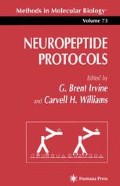Abstract
The subcellular localization of bioactive peptides, including hormones and neurotransmitters, has immense value, not only in understanding how cells function, but in correlating biochemical and clinical data from tissues in both normal and diseased states. The pioneering immunocytochemical work of Coons et al. (1) exploited the specificity of antigen-antibody interactions by using fluorescent-labeled antibodies as probes to determine the spatial distribution of antigens. It established the principles of immunocytochemistry, and thereby revolutionized the means of identifying peptide-containing cells by light microscopy. The application of immunocytochemistry at the ultrastructural level combines the specificity and sensitivity it offers with the fine spatial definition of electron microscopy, providing an exceedingly precise means of localizing the position of specific peptide antigens to a resolution of 5 nm or better. As a technique, electron microscopic immunocytochemistry was first accomplished some 35 yr ago (2, with the development of ferritin-antibody conjugates. Since then, the introduction of colloidal gold (3) as a tracer in electron microscopy, and its use as a marker for antisera (4), has established immunogold labeling as by far the most popular choice for ultrastructural localization of bioactive peptides and most other immunogens. This is not surprising since gold spheres are easily prepared in the laboratory, and are readily adsorbed by a variety of proteins, including immunoglobulins, with which they form simple but stable antibody-gold complexes without involving chemical conjugation.
Access this chapter
Tax calculation will be finalised at checkout
Purchases are for personal use only
References
Coons, A. H., Creech, H. J., Jones, R. N., and Berlmer, E. (1942) The demonstration of pneumococcal antigen in tissue by the use of fluorescent antibody. J. Immunol. 45, 159.
Singer, S. J. (1959) Preparation of an electron-dense antibody conjugate. Nature 183, 1523,1524.
Feldherr, C. M. and Marshall, J. M. (1962) The use of colloidal gold for studies of intracellular exchange in amoebaChaos chaos. J. Cell. Biol. 12, 640–645.
Faulk, W. P. and Taylor, G. M. (1971) An immunocolloid method for the electron microscope. Immunocytochemistry 8, 1081–1083.
Roth, J. (1983) The colloidal gold marker system for light and electron microscopic cytochemistry, in Immunocytochemistry, vol. 2 (Bullock, G. R. and Petrusz, P., eds.), Academic, London, pp. 217–284.
Polak, J. M. and Prtestley, J. V. (1992) Electron Microscopy Immunocytochemistry. Oxford University Press, Oxford.
Dykstra, M. J. (1993) A Manual of Applied Techniques for Biological Electron. Microscopy. Plenum, New York.
Hayat, M. A. (1989) Principles and Techniques of Electron Miroscopy Biological Applications. 3rd ed. CRC, Boca Raton, FL.
Newman, G. R. and Hobot, J. A. (1987) Modern acrylics for post-embedding immunostaining techniques. J. Histochem. Cytochem. 35, 971–981.
Tapia, F. J., Varndell, I. M., Probert, L., De Mey, J., and Polak, J. M. (1983) Double immunogold staining method for the simultaneous ultrastructural localization of regulatory peptides. J Histochem. Cytochem. 31, 977–981.
Author information
Authors and Affiliations
Editor information
Editors and Affiliations
Rights and permissions
Copyright information
© 1997 Humana Press Inc. Totowa, NJ
About this protocol
Cite this protocol
Halton, D.W., Brennan, G.P. (1997). Ultrastructural Localization of Peptides Using Immunogold Labeling. In: Irvine, G.B., Williams, C.H. (eds) Neuropeptide Protocols. Methods in Molecular Biology™, vol 73. Humana Press. https://doi.org/10.1385/0-89603-399-6:293
Download citation
DOI: https://doi.org/10.1385/0-89603-399-6:293
Publisher Name: Humana Press
Print ISBN: 978-0-89603-399-3
Online ISBN: 978-1-59259-559-4
eBook Packages: Springer Protocols

